Garlic is a basic and very popular ingredient used in many cuisines throughout the world due to its unique flavor and several health benefits. It not only adds flavor to foods, but it also has antibacterial and antioxidant benefits. Growing your own garlic may be a rewarding and cost-effective hobby that allows you to enjoy the freshest bulbs while interacting with nature. This thorough guide will walk you through the whole process of growing and harvesting garlic, from choosing the correct types to caring for your plants and obtaining a rich crop.
Choosing Garlic Varieties
 Before starting your garlic-growing adventure, it is critical to choose the proper kinds for your environment and culinary tastes. Garlic comes in two varieties: hardneck and softneck. Hardneck types are recognized for their strong tastes and flower stems, known as scapes, which can also be eaten. Softneck types, on the other hand, have milder tastes and are well-known for their braiding flexibility and extended storage life. Garlic types that are popular include ‘German White,’ ‘Purple Stripe,’ ‘Inchelium Red,’ and ‘Silverskin.’ Investigate and choose the types that best fit your preferences and growth circumstances.
Before starting your garlic-growing adventure, it is critical to choose the proper kinds for your environment and culinary tastes. Garlic comes in two varieties: hardneck and softneck. Hardneck types are recognized for their strong tastes and flower stems, known as scapes, which can also be eaten. Softneck types, on the other hand, have milder tastes and are well-known for their braiding flexibility and extended storage life. Garlic types that are popular include ‘German White,’ ‘Purple Stripe,’ ‘Inchelium Red,’ and ‘Silverskin.’ Investigate and choose the types that best fit your preferences and growth circumstances.
Preparing the Soil
Garlic grows best in well-drained soil rich in organic materials. Choose a sunny area with loamy or sandy soil for your garlic garden. Begin by clearing away any weeds or grass and loosening the soil with a garden fork or tiller. To increase soil fertility and drainage, add organic matter such as compost or well-rotted manure. Garlic needs somewhat acidic soil with a pH of 6 to 7. If required, use organic soil additives such as lime or sulfur to correct the pH.
Planting Garlic
 Garlic is traditionally planted in the fall, many weeks before the ground freezes. This permits the cloves to develop roots before winter, ensuring vigorous growth the next spring. Begin by separating the garlic bulb into individual cloves, taking care not to harm them. Plant the cloves in rows 12 to 18 inches apart, approximately 2 inches deep and 4 to 6 inches apart, with the pointy end facing up. Cover the cloves with dirt and firm it firmly around them. Mulch the bed with straw or crushed leaves to help insulate the soil and keep weeds at bay.
Garlic is traditionally planted in the fall, many weeks before the ground freezes. This permits the cloves to develop roots before winter, ensuring vigorous growth the next spring. Begin by separating the garlic bulb into individual cloves, taking care not to harm them. Plant the cloves in rows 12 to 18 inches apart, approximately 2 inches deep and 4 to 6 inches apart, with the pointy end facing up. Cover the cloves with dirt and firm it firmly around them. Mulch the bed with straw or crushed leaves to help insulate the soil and keep weeds at bay.
Caring for Garlic
Garlic requires continuous hydration, particularly during its early phases of development. Water the bed on a regular basis to keep the soil equally wet but not soggy. Mulching aids with moisture retention and weed control. Remove any weeds that appear as the garlic plants develop, taking care not to harm the weak roots. Garlic will begin to develop scapes in the spring. These curling flower stems should be cut so that the plant’s energy may be directed toward bulb production. Scapes are edible and may be used in a variety of dishes.
Harvesting Garlic
 Knowing when to harvest garlic is critical for maximum bulb growth and flavor. Garlic is ready to harvest when the lower leaves turn yellow and dry out, which normally happens in mid to late summer, depending on where you live. Gently remove the dirt around the bulbs using a garden fork or shovel, taking care not to injure them. Remove the bulbs from the ground and brush away any extra soil. Allow the garlic bulbs to dry in a well-ventilated place for several weeks to ensure appropriate curing and preservation. Trim the roots and crowns once the outer skin has dried and set, leaving approximately an inch connected to the bulb.
Knowing when to harvest garlic is critical for maximum bulb growth and flavor. Garlic is ready to harvest when the lower leaves turn yellow and dry out, which normally happens in mid to late summer, depending on where you live. Gently remove the dirt around the bulbs using a garden fork or shovel, taking care not to injure them. Remove the bulbs from the ground and brush away any extra soil. Allow the garlic bulbs to dry in a well-ventilated place for several weeks to ensure appropriate curing and preservation. Trim the roots and crowns once the outer skin has dried and set, leaving approximately an inch connected to the bulb.
Storing Garlic
Proper storage is critical for preserving the quality and flavor of your harvested garlic. Cure the bulbs in a cool, dry, and well-ventilated location, ideally with temperatures ranging from 50 to 60°F (10-15°C) and low humidity. Refrigerated storage of garlic should be avoided since the chilly temperatures might induce the bulbs to sprout prematurely. Choose mesh bags, baskets, or well-ventilated containers that enable air circulation instead. Garlic can be stored properly for several months, allowing you to enjoy your crop throughout the year.



